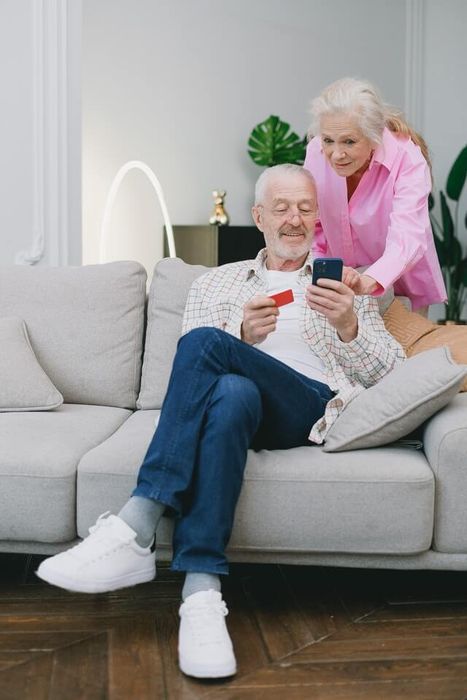Older People May Reluctantly Accept Gerontechnology - But There Are Some Ways to Change This

Despite its hardships, the pandemic did yield one positive outcome. It motivated dwelling-confined older adults to digitally connect with their outside worlds. They relied on Smartphones, iPads, and computers to become text, video chat, telehealth, social media, and internet users.
These connections enabled a growing majority to keep in touch with family and friends, access food delivery, e-commerce sites, and even their physicians. They also kept informed about everyday events by depending on voice-activated audio assistants, such as Alexa, Siri, and Google Assistant.
Becoming homebound could no longer be simply equated with social isolation.
Vendors and providers are now asking older persons—especially those in their 70s and over—to take another gerontechnology leap. They are pushing smart home devices, a technology they argue will enable them to age in place longer in their current dwellings and feel safe and independent.
Despite the apparent appeal of such claims, I expect that our older population will only be reluctant adopters.
After briefly describing these new smart home solutions, there may be reasons why older people may be less enthused. But I also believe there are some ways in how we might be able persuade this large and fast-growing group of consumers to embrace this new technology.
Thinking Forward: Worst Case Scenarios
It is unpleasant to think about the downsides of getting old in our current homes. However, consider the following list of symptoms, behaviors, and events that could signify trouble ahead:
A serious stroke.
A serious fall.
Blood pressure or blood sugar suddenly rises and stays high.
Urination in bed.
Blood in our stools.
Bathroom visited multiple times a night.
Continually high emotional stress levels.
Bedroom not left entire day.
Eating unhealthy food.
Dehydration.
No visitors for a long period.
Very low exercise levels.
Refrigerator is not opened even once the entire day.
Prescribed medicines are taken incorrectly.
Remain on the couch the entire day.
Dangerously high room temperatures.
Water leaks.
Mold behind the refrigerator.
Poorly lighted dwelling.
Smart Home Technologies
We can't always avoid these unfortunate happenings, but we can better anticipate, monitor, and manage their occurrence and then aggressively act.
Achieving this is the promise of smart home devices. They have sensor-based technologies that collect real-time information about older persons' bodies, behaviors, and activities and the physical conditions of their dwellings.
When they detect atypical data patterns, they can alert older persons, designated family members, and health care professionals, who respond with emergency or scheduled interventions.
It's good to know that these devices typically do not include video cameras, which many experts view as an overly invasive monitoring technique.
Instead, their sensors detect motions, vibrations, heat, light, pressure, moisture, or magnetic connections. They also "passively" detect and communicate older people's problems to others.
So, when an older woman falls, perhaps because of a stroke, she does not have to push a button, pull a cord, or issue a verbal command to get help. The alert and response occur without older persons taking such actions.
These sensors can be everywhere.
They can be found in the smartphones of older persons and their clothing, bracelets, and necklaces. Scarily, they can even be implanted in their bodies. They can also be inserted in their dwellings' walls, floors, lighting, air/heating equipment, appliances, furniture, and beds. And in the not-too-distant future, look for robots with human-like movements and appearances incorporating all these sensors.
Reasons Older Persons will Adopt this Technology
When considering whether to adopt or not, older persons must ask three questions:
First, are these valuable and effective solutions? Do they solve the most relevant problems? Will I get the immediate or long-term help that I require? Overall, do they make it more likely that I can age in place or stay put in my familiar abode?
Second, do they have affordable purchase prices (or monthly leasing costs) and upkeep expenditures? Will private or public health insurance defray their costs?
Third, are they easy and comfortable to use because their design and operation features do not make me feel anxious, frustrated, fearful, or inept? Do they unobtrusively monitor my risks? Is there someone to talk to when operating challenges arise? Will I have an overall positive user experience?
But there are Barriers to Adoption—The Fears of Older People
However, even positive answers to the above questions may not be enough to sway older persons. When they make their adoption deliberations, they must consider undesirable outcomes that are neither intended nor always anticipated by technology providers—what I have called collateral damages.
Here are six reasons that make older persons reluctant adopters:
#1: These devices are voracious information collectors, monitoring the most confidential and personally sensitive information about their bodies, behaviors, and activities. This means they are working well. But older people have a different take. They fear always being on alert for messages that something is wrong and feeling anxious and threatened all the time.
#2: Older persons worry about being unable to control who uses, shares, and discloses this information. They fear being powerless to counter and control unfavorable personal evaluations. They worry about being exploited by unscrupulous health care providers. Their vulnerability is why they contemplated introducing this technology into their homes. But it also makes them easier victims of data violations, social media exploitations, and fraudulent internet behaviors.
#3: They fear the dehumanizing effects of these new technologies. Will those monitoring their conditions forget that they are dealing with real people? Will artificial intelligence algorithms and impersonal machine technologies accurately portray their individual and home-based challenges? Or will they merely become sterile data summaries? And if they adopt this technology, will they be less likely to enjoy the hands-on and compassionate caring of an adult son or daughter or the in-home assistance of trusted professionals?
#4: They worry about becoming overdependent on these devices. Will they become overconfident and take too many risks—knowing that help is "on the way"? What happens when these sensors stop working because of power and internet failures? It's not just about losing food in a shut-off refrigerator. So much more is on the line.
#5: And then older people worry about losing the essence of their homes. After they closed the doors and shades of their house or apartment, they could always be their true selves. As the humanist Tuan expresses, the home is the only place where we "no longer maintain a brave front before the world" and can avoid the "glare of the public eye." It is the final frontier where older people control the scrutiny of others. Now their homes would no longer be impervious to such intrusions.
#6: Their last concern may be the least appreciated. Paradoxically, older persons fear this technology will accelerate rather than delay their transitions to their families' homes or senior housing and care developments. Under constant surveillance, they are far more likely to broadcast their problems to families and health care providers. A fall is still recorded as a fall, even when it only results in minor bruises. Maintaining the illusion of being independent and capable becomes far more difficult. Consequently, older persons worry that these devices will offer compelling evidence of their inability to remain in their current homes. So, the promise of a more protective dwelling environment is the very reason not to adopt these technologies.
Herein Lies the Dilemma
Please don't misinterpret what I am saying. I am drawing attention to these concerns not to discourage older people from becoming technology adopters. Instead, it is for them (and vendors) to understand why they might feel threatened by these innovative products.
Even though these smart home devices help them feel more autonomous and secure, they simultaneously require them to relinquish some modicum of control of their bodies, activities, and environs to the decisions of outsiders. Although some research suggests they are willing to make this tradeoff, it is too early to make predictions.
Alleviating These Fears
So how then can we motivate an aging population to adopt these products?
Vendors and suppliers must not only be able to offer positive answers to those three earlier cited questions about their merits. They must also be upfront about their downsides. Older persons want to know about the less apparent and unfavorable consequences of adopting them. They want information that is complete, accurate, and trustworthy. And, yes, if their dignity remains intact, they will not be offended by some handholding.
They want the sellers of these products to sensitively address those "collateral damage" concerns.
Will they be around when troubles arise? And even well-intentioned adult sons, daughters, and siblings must be wary of becoming helicopter family caregivers—"overcontrolling, overprotecting and overperfecting."
They must not let their zeal to introduce these solutions blind them to the threats they pose to their loved ones. Will they be around to advocate for their rights?
The Government Solution
Local, state/provincial, or federal governments also have a role to play. At different government levels in Canada and the United States are offices staffed by long-term care ombudspersons. They handle complaints, resolve problems made by or on behalf of residents of long-term care homes and facilities, and advocate for care improvements.
We should create a comparable governmental unit staffed by a gerontechnology ombudsperson.
This office would also mediate conflicts and problems but those arising from the use of these devices. Although far from a perfect solution, it is easy to make a case for such an office. Any new product that targets more vulnerable older consumers is likely to result in incidents of abuse, false claims, and bad outcomes.
Such a gerontechnology ombudsperson should be a win-win for older consumers and the suppliers of these tech products. Older persons can be more confident that they have an impartial government office advocating for their needs. And vendors would benefit from older consumers being more willing to adopt this potentially intrusive aging in place solution because of oversight assurances.
Technology and all it's future innovations can offer some amazing solutions and benefits to an older population. They could help them to live independent, safe and healthy lives.
But the active engagement, understanding and listening to older people's potential issues and concerns is going to be a fundamental requirement for successful gerontechnology implementation.
About the Author
Stephen M. Golant, Ph.D., is a leading national speaker, author, and researcher on the housing, mobility, transportation, and long-term care needs of older adult populations. He is a Fellow of the Gerontological Society of America, a Fulbright Senior Scholar award recipient, and a Professor at the University of Florida. Golant’s latest book is Aging in The Right Place, published by Health Professions Press. You can contact him at [email protected]



